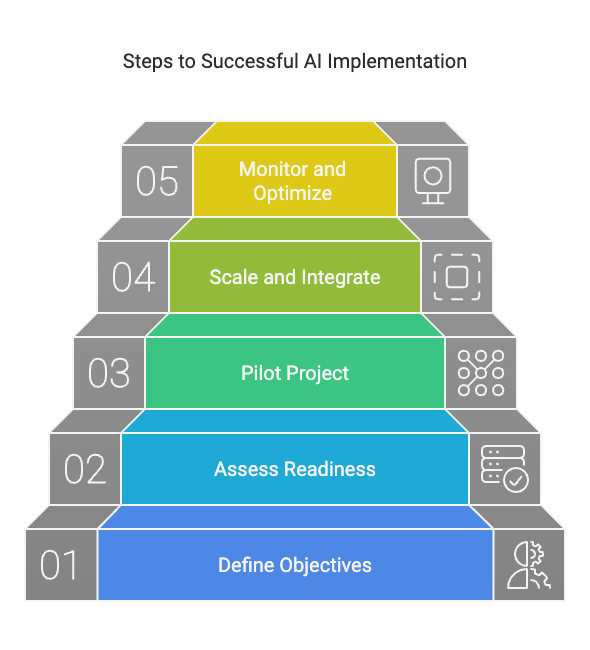Roadmap
Developing a strategic plan for AI implementation in your organization
Risk Assessment in AI Implementation

1. Define Objectives and Prioritize Use Cases
The foundation of successful AI implementation lies in clear objective setting and use case prioritization. According to Microsoft's AI Strategy Roadmap, organizations that begin with well-defined objectives are significantly more likely to achieve successful outcomes[1].
Understanding your business challenges comes first. This means conducting thorough analysis of operational inefficiencies, market opportunities, and competitive pressures. Work with stakeholders across departments to identify pain points that AI could potentially address. Look for areas where AI can create the most significant impact with reasonable implementation effort.
When selecting use cases, prioritize those that align with your core business objectives while remaining technically feasible. Consider both the potential impact and the complexity of implementation. The most successful organizations often start with use cases that offer clear ROI and manageable technical challenges.
2. Assess Readiness and Build a Strategy
Readiness assessment provides the groundwork for successful implementation. Forbes' analysis shows that organizations must thoroughly evaluate their current capabilities before proceeding with AI initiatives[2]. This includes assessing your technical infrastructure, data quality and availability, and existing talent pool.
Infrastructure evaluation should cover both hardware and software capabilities. Consider your data storage systems, processing power, and network capabilities. Assess whether your current systems can support AI implementation or if upgrades will be necessary.
Data readiness proves particularly crucial. Examine your data quality, quantity, and accessibility. Consider privacy requirements, security needs, and regulatory compliance. Build a clear understanding of any data gaps that need addressing.
Your strategy should include detailed timelines, resource allocation plans, and clear milestones. Set realistic timeframes that account for both technical implementation and organizational change management needs.
3. Start with a Pilot Project
Pilot projects offer a low-risk way to test AI implementation. According to Microsoft's implementation research, successful organizations typically start with focused pilot projects that allow for learning and adjustment[3].
Choose a pilot project that balances impact with manageability. Look for an area where success can be clearly measured and where stakeholder support is strong. The pilot should be substantial enough to prove value but contained enough to manage risk.
Establish clear metrics for measuring pilot success. Include both technical performance indicators and business impact measures. Create mechanisms for collecting feedback from all stakeholders involved in the pilot.
4. Scale and Integrate
Scaling requires careful planning and execution. RapidCanvas's implementation guide emphasizes the importance of systematic scaling approaches that consider both technical and organizational factors[4].
Begin scaling by thoroughly analyzing pilot results. Identify what worked well and what needs adjustment. Use these insights to refine your implementation approach before expanding to other areas. Consider both technical improvements and process adjustments.
Integration with existing systems and workflows demands particular attention. Work closely with IT teams to ensure smooth integration with current systems. Consider how AI solutions will affect existing processes and plan accordingly.
5. Monitor, Optimize, and Train
Continuous monitoring and optimization ensure long-term success. Establish robust monitoring systems that track both technical performance and business impact. Create clear feedback loops that allow for rapid identification and resolution of issues.
Training plays a crucial role in successful implementation. Develop comprehensive training programs that address both technical skills and cultural adaptation. Ensure employees understand not just how to use AI systems, but why they're beneficial.
Focus on creating a culture of continuous improvement. Encourage feedback from users and stakeholders. Use this input to guide ongoing optimization efforts.
Sources
- Evidence-based best practices for AI implementation
- Organizational readiness assessment guidelines
[3] Microsoft AI Implementation Guide
- Pilot project selection and implementation strategies
[4] RapidCanvas AI Implementation Guide
- Best practices for scaling AI solutions
Note: While this roadmap provides a structured approach to AI implementation, it should be adapted to your organization's specific needs and circumstances. Regular review and adjustment ensure continued alignment with organizational goals.